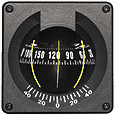Boat Compass
Boat Compass? Who needs one. I realize most people like the new GPS systems for navigation. However, I also want a compass. Here are a few tips on how to choose the right compass (besides getting one as a gift. Hint, hint!) and decide where to place it.
Many people opt for GPS navigation and neglect the old reliable compass navigation systems. The GPS can be simpler to use and often more accurate for the novice, but a good reliable compass is almost a necessity in my mind. I have had GPS screens fail, database corrupt and numerous other problems. While reliability is very high on the new electronics I always like a backup system, especially if I am going on a long trip with little service available.
What kind of Compass?
Many companies manufacture compass units. One is ComNav Marine (www.comnavmarine.com). They offer numerous models of compasses and autopilot systems that couple to the compass.
Their recommendations come from four basic questions;
What kind of boat is the compass going to be used on?
Sailboats and powerboats have different damping characteristics and heeling angle limits. These differences require a different design in the compass to compensate for those limits.
What size is the boat?
ComNav states that “the further the compass will be from the helmsman, the larger the compass you should have. If your boat is greater than 8 meters (approximately 26 feet), consider a 100 Series or larger capsule”. Lets note here that ComNav compass models are named for the apparent size of the compass card. For example, the compass card on a 70 Series compass has an apparent size of 70 mm (2 3/4 “) while the 125 Series has an apparent size of 125 mm (4.9”). ComNav says “apparent” size since the dome and fluid inside the compass magnify the actual card size.
Where will the compass be mounted?
Compass manufacturers do a very good job of designing compasses to be mounted in almost any location or position. Typical mounting styles include: bulkhead, flush-mount and bracket-mount. The biggest mounting concerns are to make sure you can easily see the compass and to keep it away from things that could effect its operation (anything that creates magnetic fields or iron.)
What kind of compensators do you need?
The more steel in the boat (steel hulls) the more important compensators will be. ComNav recommends the use of “compensators for all compass applications where the compass will be used for navigation”. They also offer a reminder that “the distance to the source of interference is more critical than the strength of it”.

